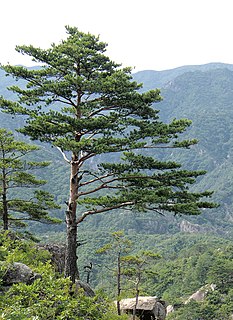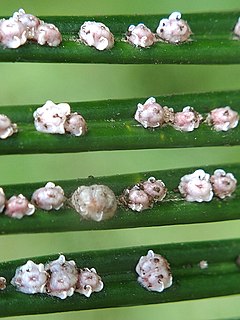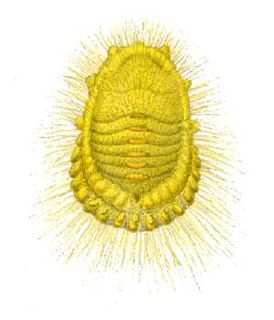
Honey is a sweet, viscous food substance made by honey bees and some related insects. Bees produce honey from the sugary secretions of plants or from secretions of other insects, by regurgitation, enzymatic activity, and water evaporation. Bees store honey in wax structures called honeycombs. The variety of honey produced by honey bees is the best-known, due to its worldwide commercial production and human consumption. Honey is collected from wild bee colonies, or from hives of domesticated bees, a practice known as beekeeping or apiculture.

A pine is any conifer in the genus Pinus of the family Pinaceae. Pinus is the sole genus in the subfamily Pinoideae. The Plant List compiled by the Royal Botanic Gardens, Kew and Missouri Botanical Garden accepts 126 species names of pines as current, together with 35 unresolved species and many more synonyms. Pine may also refer to the lumber derived from pine trees; pine is one of the more extensively used types of wood used as lumber.

Whiteflies are Hemipterans that typically feed on the undersides of plant leaves. They comprise the family Aleyrodidae, the only family in the superfamily Aleyrodoidea. More than 1550 species have been described.

Pinus brutia is a pine native to the eastern Mediterranean region. The bulk of its range is in Turkey, but it also extends to southeasternmost Bulgaria, the East Aegean Islands of Aegean Sea, Crete, the Crimea, Iran, Georgia, Azerbaijan, northern Iraq, western Syria, Israel, north-west Jordan, Lebanon, and Cyprus. It generally occurs at low altitudes, mostly from sea level to 600 metres (2,000 ft), up to 1,200 metres (3,900 ft) in the south of its range.

Scale insects are small insects of the order Hemiptera, suborder Sternorrhyncha. Of dramatically variable appearance and extreme sexual dimorphism, they comprise the superfamily Coccoidea. Adult females typically have soft bodies and no limbs, and are concealed underneath domed scales, extruding quantities of wax for protection. Some species are hermaphroditic, with a combined ovotestis instead of separate ovaries and testes. Males, in the species where they occur, have legs and sometimes wings, and resemble small flies. Scale insects are herbivores, piercing plant tissues with their mouthparts and remaining in one place, feeding on sap. The excess fluid they imbibe is secreted as honeydew on which sooty mold tends to grow. The insects often have a mutualistic relationship with ants, which feed on the honeydew and protect them from predators. There are about 8,000 described species.

Pinus halepensis, commonly known as the Aleppo pine, is a pine native to the Mediterranean region. Its range extends from Morocco, Algeria, Tunisia and Spain north to southern France, Malta, Italy, Croatia, Montenegro, and Albania, and east to Greece. There is an outlying population in Syria, Lebanon, southern Turkey, Palestine, Jordan, and Israel.

Honeydew is a sugar-rich sticky liquid, secreted by aphids and some scale insects as they feed on plant sap. When their mouthpart penetrates the phloem, the sugary, high-pressure liquid is forced out of the anus of the aphid. Honeydew is particularly common as a secretion in hemipteran insects and is often the basis for trophobiosis. Some caterpillars of Lycaenidae butterflies and some moths also produce honeydew.
Pine honey Turkish: çam balı is a type of honeydew honey. It is a sweet and spicy honey, with some woody notes, a resinous fragrance and dark amber color. It is a common breakfast dish in Turkey, where it is drizzled over yoghurt and eaten with bread.

The Margarodidae or ground pearls are a family of scale insects within the superfamily Coccoidea. Members of the family include the Polish cochineal and Armenian cochineal and the original ground pearl genus, Margarodes. Beginning in 1880, a number of distinct subfamilies were recognized, with the giant coccids being the first. Although Maskell proposed a new family, many continued to regard the monophlebids as a mere subfamily for many years, and the Margarodidae classification continued to be polyphyletic through the 20th Century. Since then, taking the advice of Koteja several subfamilies and tribes have been elevated into their own families such as Matsucoccidae and Xylococcidae. The pared-down family of Margarodidae is monophyletic.
Paratachardina pseudolobata, the lobate lac scale, is a polyphagous and pestiferous lac scale insect, which damages trees and woody shrubs in Cuba, Florida, the Bahamas and the Australian territory of Christmas Island. It was mistakenly identified as Paratachardina lobata (Chamberlin), an insect native to India and Sri Lanka, but was in 2007 recognized and named as a distinct species based on material from Florida; its native distribution is as yet unknown. The new lac insect was described based on all stages of the female, during the revision of the genus Paratachardina, wherein all its known species were redescribed.

Trophobiosis is a symbiotic association between organisms where food is obtained or provided. The provider of food in the association is referred to as a trophobiont. The name is derived from the Greek τροφή trophē, meaning "nourishment" and -βίωσις -biosis which is short for the English symbiosis.
Conchaspididae is a small family of scale insects known as false armoured scales because of their resemblance to Diaspididae.

Eriococcidae is a family of scale insects in the order Hemiptera. They are commonly known as felt scales or eriococcids. Each species is usually specific to a different plant host, or closely related group of hosts.
Micrococcidae is a family of scale insects commonly known as the Mediterranean scales. There are two genera and eight species. Members of this family are found in Cyprus, Italy and other Mediterranean countries including Egypt, France, Greece, Israel, Lebanon, Libya, Syria and Turkey.

Monophlebidae is a family of scale insects commonly known as the giant scales or monophlebids. They occur in most parts of the world but more genera are found in the tropics than elsewhere.
Phenacoleachiidae is a family of scale insects commonly known as the phenacoleachiids. They are found only in the South Island of New Zealand, and on certain offshore islands. There are two species in a single genus.
The scale insect genus Desmococcus is a group in the family Pityococcidae, comprising two species from the western United States, feeding on pines. The type species is Desmococcus captivus
John Stuart Noyes is a Welsh entomologist.

Physokermes are a genus of scale insects known as the bud scales. They are restricted to the Holarctic, though Physokermes hemicryphus has been introduced to North America. Some species are plant pests.
Trabutina is a genus of "blue-green" mealybugs, containing five species: T. crassispinosa, T. elastica, T. mannipara, T. serpentina, and T. tenax. This genus of scale insects feeds solely on plants of the genus Tamarix. Its type species is T. mannipara.












